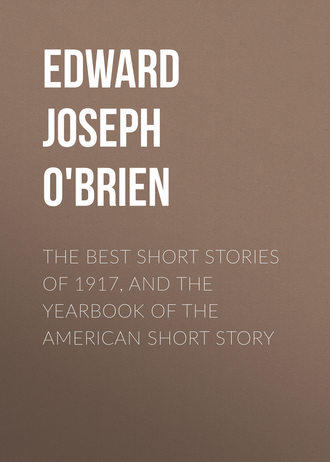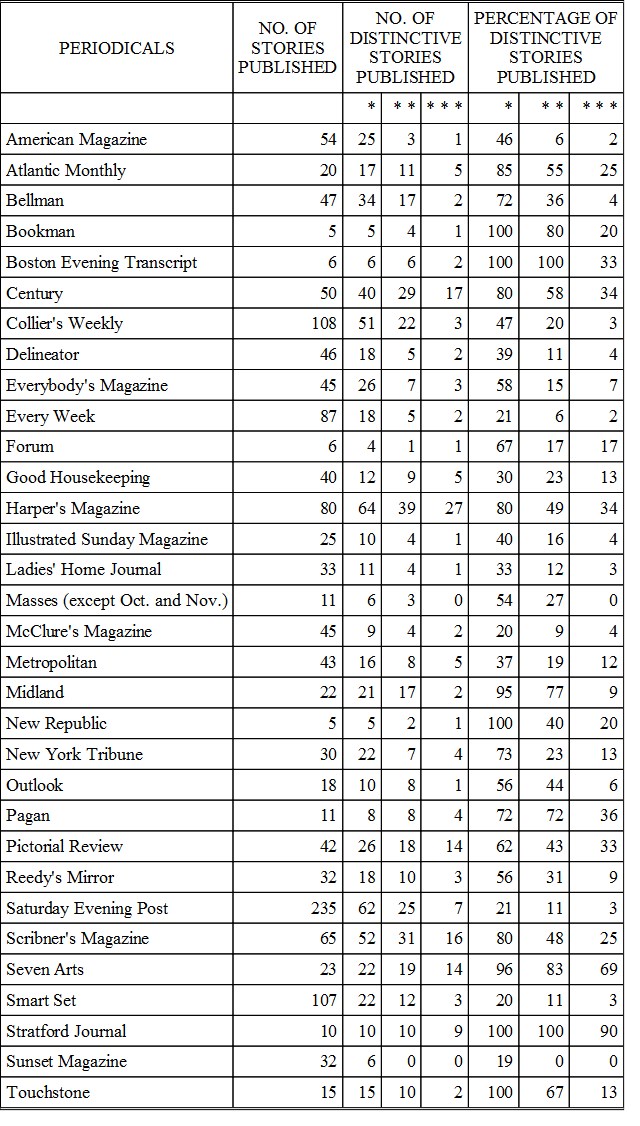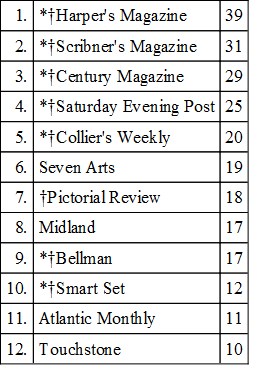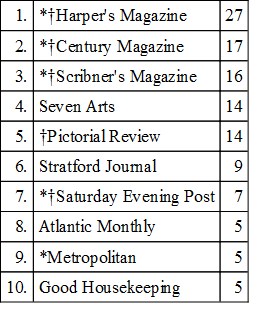 полная версия
полная версияThe Best Short Stories of 1917, and the Yearbook of the American Short Story
31. His Father's Flag by Armistead C. Gordon (Scribner's Magazine). The many readers who have revelled in Mr. Gordon's admirable portraits of Virginia negro plantation life will be surprised and gratified at Mr. Gordon's venture in this story into a new field. This story has all the infectious emotional feeling of memory recalling glorious things, and I can only compare it for its spiritual fidelity toward a cause to the stories by Elsie Singmaster which she has gathered into her volume about Gettysburg, and particularly to that fine story, "The Survivors."
32. The Bunker Mouse, and 33. "Molly McGuire, Fourteen" by Frederick Stuart Greene (The Century Magazine). Captain Greene's story "The Cat of the Cane-Brake" attracted so much attention at the time of its publication in the Metropolitan Magazine a year ago that it is interesting to find him achieving high distinction in other imaginative fields. Captain Greene's natural gift of narrative is the result of a strong impulse toward creative expression, which molds its form a little self-consciously, but convincingly, for the most part. I think that he is at his best in these two stories rather than in "The Cat of the Cane-Brake" and "The Black Pool," because they are based upon a more direct apprehension and experience of life. "Molly McGuire, Fourteen" adds one more tradition to those of the Virginia Military Institute.
34. Rainbow Pete by Richard Matthews Hallet (The Pictorial Review) reveals the author in his most incorrigibly romantic mood. Mr. Hallet casts glamour over his creations, partly through his detached and pictorial perception of life, and partly through the magic of his words. He has been compared to Conrad, and in a lesser way he has much in common with the author of "Lord Jim," but his artistic method is essentially different and quite as individual.
35. Frazee by Lee Foster Hartman (Harper's Magazine). Mr. Hartman has been a good friend to other story writers for so long that we had begun to forget how fine an artist he can be himself. In "Frazee" he has taken a subject which would have fascinated Mrs. Gerould and handled it with reserve and power. It is pitched in a quieter key than is usual in such a story, and the result is that character merges with atmosphere almost imperceptibly. I regard the story as almost a model of construction for students of short story writing.
36. Four Days by Hetty Hemenway (Atlantic Monthly). This remarkable story of the spiritual effect of the war upon two young people was so widely commented upon, not only after its appearance in the Atlantic Monthly, but later when it was republished in book form, that I shall only commend it to the reader here as an artistically woven study in war psychology.
37. Get Ready the Wreaths by Fannie Hurst (Cosmopolitan Magazine). The artistic qualities in Miss Hurst's work which have commended themselves to such disinterested critics as Mr. Howells are revealed once more in this story, in which Miss Hurst accepts the shoddiness of background which characterizes her literary types, and reveals the fine human current that runs beneath it all. I am not sure that Miss Hurst has not diluted her substance a little too much during the past year, and in any case that danger is implicit in her method. But in "Get Ready the Wreaths" the emotional validity of her substance is absolutely unimpeachable and her handling of the situation it presents is adequate and fine.
38. Journey's End by Percy Adams Hutchison (Harper's Magazine). An attentive reader of the American short stories during the past few years may have observed with interest at rare intervals the work of Mr. Hutchison. In it there was always a promise of an achievement not unlike that of Perceval Gibbon, but a certain looseness of texture prevented Mr. Hutchison from being completely persuasive. In "Journey's End," however, it must be confessed that he has written a memorable sea story that is certainly equal at least to the better stories in Mr. Kipling's latest volume.
39. The Strange-Looking Man by Fanny Kemble Johnson (The Pagan). I suppose that this story is to be regarded as a sketch rather than a short story, but in any case it is a vividly rendered picture of war's effects portrayed with subtle irony and quiet art. I associate it with "Chautonville" by Will Levington Comfort, and "The Flying Teuton" by Alice Brown, as one of the three stories with the most authentic spiritual message in American fiction that the war has produced.
40. The Sea-Turn by E. Clement James (The Seven Arts). In this study of the spiritual reactions of a starved environment upon an imaginative mind, Mrs. Jones has added a convincing character portrait to American letters which ranks with the better short stories of J. D. Beresford in a similar genre. The story is in the same tradition as that of the younger English realists, but it is an essential contribution to our nationalism, and as such helps to point the way toward the future in which a true national literature must find its only and inevitable realization.
41. The Caller in the Night by Burton Kline (The Stratford Journal). I believe that Mr. Kline has completely realized in this story a fine imaginative situation and has presented a folk story with a significant legendary quality. It is in the tradition of Hawthorne, but the substance with which Mr. Kline deals is the substance of his own people, and consequently that in which his creative impulse has found the freest scope. It may be compared to its own advantage with "The Lost Phoebe" by Theodore Dreiser, which was equally memorable among the folk-stories of 1916, and the comparison suggests that in both cases the author's training as a novelist has not been to his disadvantage as a short-story teller.
42. When Did You Write Your Mother Last? by Addison Lewis (Reedy's Mirror). This is the only story I have read in three years in which it seemed to me that I found the authentic voice of "O. Henry" speaking. Mr. Lewis has been publishing a series of these "Tales While You Wait" in Reedy's Mirror during the past few months, and I should much prefer them to those of Jack Lait for the complete success with which he has achieved his aims. Imitation of "O. Henry" has been the curse of American story-telling for the past ten years, because "O. Henry" is practically inimitable. Mr. Lewis is not an imitator, but he may well prove before very long to be "O. Henry's" successor. In the words of Padna Dan and Micus Pat, "Here's the chance for some one to make a discovery."
43. Widow La Rue by Edgar Lee Masters (Reedy's Mirror). This is the best short story in verse that the year has produced, and as literature it realizes in my belief even greater imaginative fulfilment than "Spoon River Anthology." I should have most certainly wished to include it in "The Best Short Stories of 1917" had it been in prose, and it adds one more unforgettable legend to our folk imagination.
44. The Understudy by Johnson Morton (Harper's Magazine) is an ironic character study developed with much finesse in the tradition of Henry James. Its defect is a certain conventional atmosphere which demands an artificial attitude on the part of the reader. Its admirable distinction is its faithful rendering of a personality not unlike the "Tante" of Anne Douglas Sedgwick, if a novel portrait and a short story portrait may fittingly be compared. If the portraiture is unpleasant, it is at any rate rendered with incisive kindliness.
45. The Heart of Life by Meredith Nicholson (Scribner's Magazine). Mr. Nicholson has treated an old theme freshly in "The Heart of Life" and discovered in it new values of contrasting character. Among his short stories it stands out as notably as "A Hoosier Chronicle" among his novels. It is in such work as this that Mr. Nicholson justifies his calling, and it is by them that he has most hope of remembrance in American literature.
46. Murder? by Seumas O'Brien (The Illustrated Sunday Magazine). With something of Hardy's stark rendering of atmosphere, Mr. O'Brien has portrayed a grim situation unforgettably. Woven out of the simplest elements, and with an entire lack of literary sophistication, his story is fairly comparable to the work of Daniel Corkery, whose volume, "A Munster Twilight," has interested me more than any other volume of short stories published in America this year. The story is of particular interest because Mr. O'Brien's reputation as an artist has been based solely upon his work as a satirist and Irish fabulist.
47. The Interval by Vincent O'Sullivan (Boston Evening Transcript). It is odd to reflect that a literary artist of Mr. O'Sullivan's distinction is not represented in American magazines during 1917 at all, and that it has been left to a daily newspaper to publish his work. In "The Interval," Mr. O'Sullivan has sought to suggest the spiritual effect of the war upon a certain type of mind. He has rendered with faithful subtleness the newly aroused longing for religious belief or some form of concrete spiritual expression that bereavement brings. This state has a pathos of its own that the author adequately realizes in his story, and his irony in portraying it is Gallic in its quality.
48. Bixby's Bridge by Georgia Wood Pangborn (Harper's Magazine). Mrs. Pangborn is well known for her artistic stories of the supernatural, and this will rank among the very best of them. She shares with Algernon Blackwood that gift for making spiritual illusion real which is so rare in contemporary work. What is specially distinctive is her gift of selection, by which she brings out the most illusive psychological contrasts.
49. "A Certain Rich Man—," by Lawrence Perry (Scribner's Magazine). I find in this story an emotional quality keyed up as tightly, but as surely, as in the best short stories by Mary Synon. Remote as its substance may seem, superficially, it touches the very heart of the experience that the war has brought to us all, and reveals the naked stuff out of which our war psychology has emerged.
50. The Portrait by Emery Pottle (The Touchstone). This study in Italian backgrounds is by another disciple of Henry James, who portrays with deft sure touches the nostalgia of an American girl unhappily married to an Italian nobleman. It just fails of complete persuasiveness because it is a trifle overstrung, but nevertheless it is memorable for its artistic sincerity.
51. The Path of Glory by Mary Brecht Pulver (Saturday Evening Post). This story of how distinction came to a poor family in the mountains through the death of their son in the French army is simply told with a quiet, unassuming earnestness that makes it very real. It marks a new phase of Mrs. Pulver's talent, and one which promises her a richer fulfilment in the future than her other stories have suggested. Time and time again I have been impressed this year by the folk quality that is manifest in our younger writers, and what is most encouraging is that, when they write of the poor and the lowly, there is less of that condescension toward their subject than has been characteristic of American folk-writing in the past.
52. Miss Fothergill by Norval Richardson (Scribner's Magazine). The tradition in English fiction, which is most signally marked by "Pride and Prejudice," "Cranford," and "Barchester Towers," and which was so pleasantly continued by the late Dr. S. Weir Mitchell and by Margaret Deland, is admirably embodied in the work of this writer, whose work should be better known. The quiet blending of humor and pathos in "Miss Fothergill" is unusual.
53. The Scar That Tripled by William Gunn Shepherd (Metropolitan Magazine) is none the less truly a remarkable short story because it happens to be based on fact. "The Deserter" was the last fine short story written by the late Richard Harding Davis, and "The Scar That Tripled" is the engrossing narrative of the adventure which suggested that story. Personally, I regard it as superior to "The Deserter."
54. A Country Christmas by Grant Showerman (Century Magazine). Professor Showerman's country chronicles are now well known to American readers, and this is quite the best of them. These sketches rank with those of Hamlin Garland as a permanent and delightful record of a pioneer life that has passed away for ever. Their deliberate homeliness and consistent reflection of a small boy's attitude toward life have no equal to my knowledge.
55. The Christmas Angel (The Pictorial Review), and 56. The Flag of Eliphalet (Boston Evening Transcript) by Elsie Singmaster add two more portraits to the pleasant gallery of Elsie Singmaster's vivid creations. Although her vein is a narrow one, no one is more competent than she in its expression, and few surpass her in the faithful rendering of homely but none the less real spiritual circumstance.
57. The End of the Road by Gordon Arthur Smith (Scribner's Magazine) is a sequel to "Feet of Gold" and chronicles the further love adventures of Ferdinand Taillandy, and their tragic conclusion. In these two stories Mr. Smith has proven his literary kinship with Leonard Merrick, and these stories surely rank with the chronicles of Tricotrin and Pitou.
58. Ching, Ching, Chinaman (Pictorial Review), 59. Ked's Hand (Harper's Magazine), 60. White Hands (Pictorial Review), and 61. The Woman at Seven Brothers (Harper's Magazine) by Wilbur Daniel Steele. With these four stories, together with "A Devil of a Fellow," "Free," and "A Point of Honor," Mr. Steele assumes his rightful place with Katharine Fullerton Gerould and H. G. Dwight as a leader in American fiction. "Ching, Ching, Chinaman," "White Hands," and "The Woman at Seven Brothers" are, in my belief, the three best short stories that were published in 1917, by an American author, and I may safely predict their literary permanence. Mr. Steele's extraordinary gift for presenting action and spiritual conflict pictorially is unrivalled, and his sense of human mystery has a rich tragic humor akin to that of Thomas Hardy, though his philosophy of life is infinitely more hopeful.
62. None so Blind by Mary Synon (Harper's Magazine) is a study in tragic circumstance, the more powerful because it is so reticently handled. It is Miss Synon's first profound study in feminine psychology, and reveals an unusual sense of emotional values. Few backgrounds have been more subtly rendered in their influence upon character, and the action of the story is inevitable despite its character of surprise.
63. The Scar by Elisabeth Stead Taber (The Seven Arts). The brutal realism of this story may repel the reader, but its power and convincing quality cannot be gainsaid. So many writers have followed John Fox's example in writing about the mountaineers of the Alleghanies, that it is gratifying to chronicle so exceptional a story as this. It is as inevitable in its ugliness as "The Cat of the Cane-Brake" by Frederick Stuart Greene, and psychologically it is far more convincing.
MAGAZINE AVERAGES FOR 1917
The following table includes the averages of American periodicals published during 1917. One, two, and three asterisks are employed to indicate relative distinction. "Three-asterisk stories" are of somewhat permanent literary value. The list excludes reprints.

The following tables indicate the rank, during 1917, by number and percentage of distinctive stories published, of the nineteen periodicals coming within the scope of my examination which have published during the past year over twenty-five stories and which have exceeded an average of 15% in stories of distinction. The lists exclude reprints.

The following periodicals have published during 1917 ten or more "two-asterisk stories." The list excludes reprints. Periodicals represented in this list during 1915 as well are indicated by an asterisk. Periodicals represented in this list during 1916 are indicated by a dagger.

The following periodicals have published during 1917 five or more "three-asterisk stories." The list excludes reprints. Periodicals represented in this list during 1915 as well are indicated by an asterisk. Periodicals represented in this list during 1916 are indicated by a dagger.

Ties in the above lists have been decided by taking relative rank in other lists into account.
INDEX OF SHORT STORIES FOR 1917
All short stories published in the following magazines and newspapers during 1917 are indexed.
American Magazine
Atlantic Monthly
Bellman
Bookman
Boston Evening Transcript
Century
Collier's Weekly
Current Opinion
Delineator
Everybody's Magazine
Every Week
Forum
Harper's Magazine
Illustrated Sunday Magazine
Ladies' Home Journal
Little Review (except Oct.)
Masses (Jan.-Sept.)
McClure's Magazine
Metropolitan
Midland
New Republic
New York Tribune
Outlook
Pictorial Review
Poetry
Pagan
Reedy's Mirror
Russian Review (Jan.-July)
Saturday Evening Post
Scribner's Magazine
Seven Arts
Stratford Journal
Sunset Magazine
Touchstone
Yale Review
The October and November issues of the Masses are not listed, as they were not procurable through ordinary channels. The October issue of the Russian Review was not yet published when this book went to press. The October issue of the Little Review was withdrawn from circulation before it could come to my notice.
Short stories, of distinction only, published in the following magazines and newspapers during 1917 are indexed.
Black Cat
Boston Herald
Colonnade
Cosmopolitan
Good Housekeeping
Harper's Bazar
Hearst's Magazine
Live Stories
McCall's Magazine
Milestones
Munsey's Magazine
Parisienne
Pearson's Magazine
Short Stories
Smart Set
Snappy Stories
Southern Woman's Magazine
To-day's Housewife
Woman's Home Companion
Youth's Companion
Certain stories of distinction published in the following magazines and newspapers during 1917 are indexed, because they have been called to my attention by authors or readers.
All-Story Weekly
Art World
Ainslee's Magazine
Dernier Cri
Detective Story Magazine
Los Angeles Times
Queen's Work
Saucy Stories
Top-Notch Magazine
Woman's World
Young's Magazine
The Red Book Magazine is not represented in these lists, in deference to the wishes of its editor, who sent me the following telegram: "We prefer not to be listed."
One, two, or three asterisks are prefixed to the titles of stories to indicate distinction. Three asterisks prefixed to a title indicate the more or less permanent literary value of a story, and entitle it to a place on the annual "Rolls of Honor." An asterisk before the name of an author indicates that he is not an American.
The following abbreviations are used in the index:—

A
Abbott, Frances C.
**Memorial Window, The. Del. Nov.Mrs. Bodkin's Début. Del. June.*Abdullah, Achmed. (Achmend Abdullah Nadir Khan el-Durani
el-Iddrissyeh.) ("A. A. Nadir.") (1881- .)
(See 1915 and 1916.)
(See also Uzzell, Thomas H., and Abdullah,
Achmed.)
*As He Reaped. Ain. July.*Consider the Oath of M'Taga. All. March 10.*Disappointment. All. May 19.*East or West? Top-Notch. April 15.*Five-Dollar Gold-Piece, The. Sn. St. Dec. 18.**Gamut, The. S. S. Dec.**Gentlemen of the Old Régime, A. S. S. Feb.*Guerdon, The. S. S. Feb.**Home-Coming, The. Harp. M. May.**Letter, The. S. S. Jan.**Silence. All. April 21.Adams, Katharine.
*"Silent Brown." So. Wo. M. Oct.Adams, Minnie Barbour. (See 1916.)
*Half a Boy. Pict. R. Sept.Adams, Samuel Hopkins. (1871- .) (See 1915 and 1916.)
Letter to Nowhere, A. E. W. Feb. 12.*Little Red Doctor of Our Square, The. Col Aug. 25.*Meanest Man in Our Square, The. Col. March 24.*Paula of the Housetop. Col. July 7.*Room "12 A." Ev. Nov."Wamble: His Day Out." Col. Jan. 13.
Adler, Henry.
Coward, The. Pag. Sept.*Aicard, Jean. (1848- .)
*Mariette's Gift. N. Y. Trib. Feb. 18.Alexander, Mary.
Ashamed of Her Parents. Del. Nov.Girl Who Is Not Popular, The. Del. May.How Can I Meet the Right Sort of Men? Del. March.Out of Touch With Life. Del. Oct.Too Sure of Herself. Del. July.When She Runs After the Boys. Del. Aug.Allen, Frederick Lewis. (See 1915.)
Big Game. Cen. March.Fixing Up the Balkans. Cen. May.Small Talk. Cen. Feb.Allen, Loraine Anderson.
**Going of Agnes, The. Touch. Sept.Allendorf, Anna Stahl.
*Dallying of Celia May, The. G. H. July.**Leavening of St. Rupert, The. G. H. June."Amid, John." (M. M. Stearns.) (See 1915 and 1916.)
*Alone. Det. Sept. 25.
*Busted Poor. All. Dec. 8.Freeze, The. Mid. Aug.*Interlude. Young. April.*Prem Singh. Bel. Dec. 1.***Professor, A. Mid. Nov.Strachan's Hindu. Bel. Oct. 27.Anderson, Sherwood. (See 1915 and 1916.)
***"Mother." Sev. A. March.***Thinker, The. Sev. A. Sept.***Untold Lie, The. Sev. A. Jan.Anderson, William Ashley. (See 1915 and 1916.)
**Unwrit Dogma, The. Ev. Dec.Andrade, Cipriano, Jr.
*Applied Hydraulics. S. E. P. Aug. 25.Andres, Mary Raymond Shipman. (See 1915 and 1916.)
***Blood Brothers. Scr. May.***Return of K. of K., The. McC. March.*Russian, The. Milestones. Oct.*Andreyev, Leonid Nikolaevich. (1871- .) (See 1916.)
***Lazarus. Strat. J. June.Anonymous.
Apparition, The. N. Y. Trib. Nov. 11.Coeur de Lion. N. Y. Trib. July 22.***Evocation, The. N. Y. Trib. April 22.Eyes of the Soul, The. N. Y. Trib. Feb. 25.Fools. Mir. Sept. 28.***"Huppdiwupp." Lit. R. Jan.*Pipe, The. N. Y. Trib. Nov. 4.**Poilu's Dream on Christmas Eve, The. B. Her. Dec. 23.*Rendezvous, The. N. Y. Trib. Sept. 30.**Slacker with a Soul, A. N. Y. Trib. Sept. 16.*Spirit of Alsace, The. N. Y. Trib. May 6.*Voice of the Church Bell, The. N. Y. Trib. Oct. 21.War Against War. McC. April-May.When Lulu Made Trouble. Mir. May 18.Arbuckle, Mary.
Freedom and Robbie May. Sun. Nov.Armstrong, William.
Cupid in High Finance. Del. Sept.Ashe, Elizabeth. (See 1915.)
*Appraisement. Atl. March.*Assis, Machado de. (1839-1908.) (See 1916.)
**Attendant's Confession, The. (R.) Strat. J. Dec.
Auernheimer, Raoul. (1876- .)
*Demonstrating That War Is War. N. Y. Trib. Jan. 28.*Aumonier, Stacy. (See 1915 and 1916.)
***In the Way of Business. Pict. R. March.***Packet, The. Col. May 26.***"Them Others." Cen. Aug.Austin, F. Britten. (See 1915.)
**Zu Befehl! S. E. P. Dec. 1.B
Babcock, Edwina Stanton. (See 1916.)
***Excursion, The. Pict. R. Oct.Bacon, Josephine Daskam. (1876- .) (See 1915 and 1916.)
Comrades in Arms. S. E. P. Oct. 27.*Entrances and Exits. Del. Oct.Ghost of Rosy Taylor, The. S. E. P. Nov. 17.*Magic Casements. Del. Nov.Square Peggy. S. E. P. Dec. 22.*Year of Cousin Quartus, A. Del. Feb.Bailey (Irene) Temple. (See 1915.)
*Red Candle, The. Scr. Dec.Baker, Katharine. (See 1915 and 1916.)
Fifty-Cent Kind, The. Atl. April.Ball, William David.
Man Who Paid, The. E. W. April 2.Balmer, Edwin. (1883- .) (See 1915.)
Madcap. Col. Jan. 27.S. Orton, Stockholder. E. W. May 28.Telegraph Trail, The. Col. March 17.Thing That He Did, The. L. H. J. Jan.With Sealed Hood. Col. Sept. 22.Banks, Helen Ward.
*Mrs. Pepper Passes. Y. C. April 5.*Barbusse, Henri.
**Paradis Polishes the Boots. (R.) C. O. Dec.
Barnard, Floy Tolbert. (1879- .) (See 1916.)
***Surprise in Perspective, A. Harp. M. April.Barry, Richard. (1881- .)




